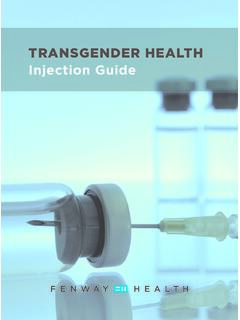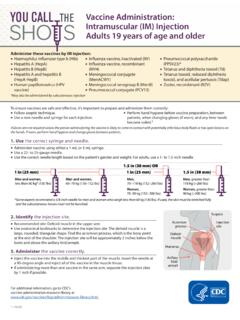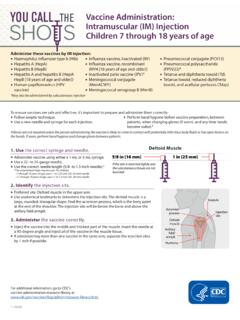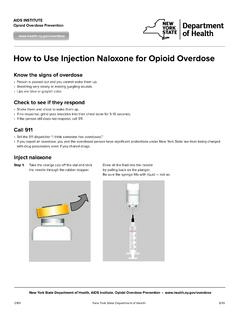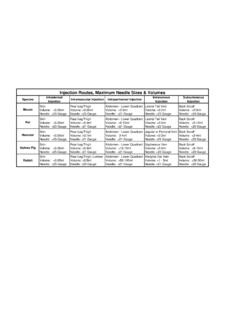Transcription of Intraperitoneal (IP) Injection in Rats and Mice SOP
1 Page 1 of 6 UBC Animal Care Guidelines SOP: ACC 2012 Tech10 Submitted by: Kris Andrews Last date revised: May 2014 Date approved: June 2014 Intraperitoneal (IP) Injection in Rats and Mice SOP Purpose This Standard Operating Procedure (SOP) describes the procedure of Intraperitoneal (IP) Injection in rats and mice. This SOP follows the CCAC guidelines for acceptable Injection volumes in rodents. Responsibility Those trained persons listed on an approved Animal Care Committee protocol performing the procedure. All animal users performing IP injections in rodents must have successfully completed the UBC Animal Care Services (or equivalent) Rodent Biology and Husbandry course. References Canadian Council on Animal Care (CCAC) guidelines ( ) Recommendations Use the manufacturer s recommended route of Injection since some drugs may have adverse side effects or cause discomfort if injected via a non recommended route. The volume to be injected should be the lowest volume possible and not exceed the current recommended guidelines (see chart below).
2 All substances for Injection should be sterile since contamination can cause infection and irritation at the site of Injection and cause clinical illness in the animals and affect research results. Warm substances to room or body temperature since Injection of cold substances can cause discomfort and drop in body temperature (if this does not damage drug). Recommended Needle size and Maximum Volume of Administration* Species Needle Gauge Volume Mouse 25 27g < 10 ml/kg : for a 25 gram mouse, the maximum volume would be ml Rat 23 25g < 10 ml/kg : for a 250 gram rat, the maximum volume would be ml*Greater than the recommended volumes should not be given unless justified and approved on the Animal Care Protocol and increased monitoring for complications implemented. Materials Syringes (appropriately sized for Injection volume) Needles (appropriately sized for animal) Sterile substance to be injected (recommended stored in sterile multi dose vials) Intraperitoneal (IP) Injection in Rats and Mice SOP Page 2 of 6 70% isopropyl alcohol (to disinfect top of multi dose vial) Gauze Heat source to warm substances to be injected (do not overheat beyond 37oC) Heating pad, water bath, holding vial in hand to warm Optional: towel for wrapping rats if performing 1 person Injection Procedure 1.
3 Disinfect top of multi dose vial with 70% alcohol and gauze. 2. Draw up, into the syringe and needle, the amount of solution to be administered (pre warm if possible). a. It is helpful to turn the needle so that the bevel points up and the numbers on the syringe barrel can be read). 3. Gently remove animal from the cage and restrain appropriately in the head down position see below and appendix. 4. Identify anatomical landmarks in order to inject into the appropriate area of the abdomen. a. Typically the Injection site will be in the animal s lower right quadrant of the abdomen to avoid damage to the urinary bladder, cecum and other abdominal organs (see pictures below). i. If injecting daily for multiple days, it is acceptable to vary the side injected between right and left but this needs to be approved on the animal care protocol. Bevel of needle facing up Intraperitoneal (IP) Injection in Rats and Mice SOP Page 3 of 6 Landmarks for IP Injection 5.
4 In both mice and rats insert needle with bevel facing up into the lower right quadrant of the abdomen towards the head at a 30 40 angle to horizontal. Insert needle to the depth in which the entire bevel is within the abdominal cavity (in fat animals, almost the entire length of the needle length may need to be inserted but in smaller mice, only about the needle length may need to be inserted). Midline of animal Genitals Just above level of hip or at level of second set of nipples Location of insertion of needle Rat Midline of animalLocation of insertion of needleJust above level of hip or at level of second set of nipples Genitals Mouse Intraperitoneal (IP) Injection in Rats and Mice SOP Page 4 of 6 Mouse Rat 6. Pull back on the plunger to ensure negative pressure prior to injecting. If there is negative pressure, proceed with the Injection depress the plunger until the solution has been fully administered. The speed of Injection depends on the volume and viscosity of the substance.
5 If injecting less than the maximum recommended volumes of aqueous solutions, the Injection can be completed in 1 2 seconds. Larger volumes or viscous substances may need to be injected over a longer time. **Do not allow the needle to move around inside the abdomen. a. Aspiration of green material likely indicates that the bowel has been punctured, while aspiration of yellow, liquid material may indicate the bladder has been punctured. The presence of blood indicates an abdominal blood vessel has been punctured. If blood, urine or gastrointestinal contents are drawn back into the hub of the needle, remove the needle from the animal. The syringe/syringe contents and needle must be discarded. The angle at which the needle is subsequently inserted should be redirected and the animal monitored closely for any signs of pain, illness, etc. 7. Pull the needle straight out and place the syringe/needle directly into a sharps container without recapping. Use a new needle and syringe for each animal.
6 8. Place the animal back into its cage and observe for any complications. Complications 1. Bleeding at Injection site apply pressure until the bleeding stops and clean with gauze and water 2. Peritonitis inflammation or infection of the peritoneal cavity (if gut is punctured or a non sterile substance injected). 3. Laceration of abdominal organs and internal bleeding or infection. 4. Injection into the gastrointestinal tract or bladder. Appendix Restraint and position of animal for IP Injection . Intraperitoneal (IP) Injection in Rats and Mice SOP Page 5 of 6 For mice: Tilt the mouse with its head slightly toward the ground so that its head is lower than its hind end. This allows the abdominal viscera to shift cranially and minimize accidental puncture of abdominal organs at site of Injection . For rats: The 2 person technique (preferred and recommended): Use the scissor or V hold. Hold the rat s head between your index and middle fingers without pressing on the trachea.
7 Wrap the remaining fingers gently around the thoracic cavity without squeezing the animal. Straighten your index and middle finger to extend the head and further restrain the rat. With your other hand, hold onto the rear feet and tail. Place a finger between legs to reduce stress on the joints. Gently stretch rat along your hand/forearm with the head held lower than the body. The second person will perform the Injection . 1 person technique: Using a facecloth or small towel, wrap the rat head first as shown below ensuring it cannot get out of the towel, without wrapping too tightly. Gently rotate the rat and towel so the rat is in dorsal recumbency ( , on its back). Place the rat s head/body along your arm and in the crook of your elbow of your non dominant arm. Use your arm/elbow to gently restrain the rat against your body. Restrain the feet/tail with your non dominant hand. Intraperitoneal (IP) Injection in Rats and Mice SOP Page 6 of 6


